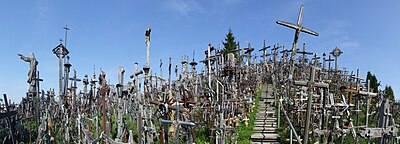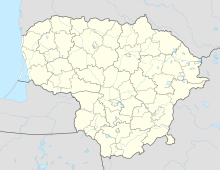Hill of Crosses
The Hill of Crosses ( Kryžių kalnas ) is a place of pilgrimage in Lithuania that is dominated by catholic and tourist .
Location, shape and customs
Coordinates: 56 ° 0 ′ 55.2 ″ N , 23 ° 24 ′ 59.6 ″ E
The mountain is about 12 km north of Šiauliai (German: Schaulen, Polish: Szawle), 1.5 km east of the A12 trunk road, which leads from Šiauliai via Joniškis to Riga . The name Berg der Kreuze is common in German usage, but due to its low height of ten meters, the name hill comes closer. A narrow staircase made of wooden planks leads over the saddle-shaped double hill. Pilgrims used to put crosses on this hill, often with a wish or thanks. The pilgrimage is individual and is not tied to any dates, but the Hill of Crosses is especially visited at weddings , births and Easter .
Legends and facts about the origin and development
There are two legends, among other things, about the origin of the hill, the erection of the crosses and the effects it triggered :
- A father fell asleep next to his sick daughter's bed; In a dream a white female figure appeared to him, who gave him the task of putting up a cross on the hill. The man did as the woman told him to do and put a cross on that very hill. When he returned home, his daughter was healthy again.
Another legend tells of a prince from Vilnius . He had tried another prince 300 years ago and traveled past the mountain to the court in Riga. He said to his servants: "If I win the trial, I will put a cross on the mountain." After the prince had won the trial, on the way back he ordered that the cross be erected on the mountain. Soon the reputation of the prince's vow spread throughout the country.
The hill is considered to be a medieval castle hill, although the castle was named Jurgaičiai and is said to have been destroyed by crusaders in 1348 . Even at that time, the at least partly artificial hill was probably a place of prayer and sacrifice .
History in the 19th and 20th centuries
After the Third Partition of Poland , Lithuania became part of the Russian Empire . In the period that followed, Poles and Lithuanians rebelled twice against the Russian authorities, in the November uprising of 1830/31 and in the January uprising of 1863/64. Both revolts against the tsarist regime were brutally suppressed. At this time, residents of the area are said to have started to set up crosses on the hill for relatives who were killed in the riots and who they did not know where they were buried. Other sources believe that the insurgents were executed on the hill.
In 1900 there were 150 and 1940 about 400 crosses on the hill. After the Soviet Union occupied Lithuania in June 1940 and more than 100,000 Lithuanians were deported to Siberia in 1940/1941 and again from 1945 to 1953 , the erection of the crosses decreased. When, after Stalin's death in 1953, the survivors among the deportees gradually returned from Siberia, they immediately put up crosses in memory of those who had died in the Gulag . Likewise, many political prisoners and believers erected other crosses. As a result, the Lithuanian pilgrimage site increasingly became a political symbol against the communist rule of the Soviets in Lithuania. The hill was therefore increasingly a thorn in the side of the communist regime in Lithuania, and on June 16, 1959, the Central Committee of the Communist Party of Lithuania dealt with the hill for the first time . It was decided to destroy the supposedly holy place. The first extermination operation took place on April 5, 1961. The crosses were bulldozed down, 2,179 crosses were fetched from the hill and the wooden crosses burned. Iron crosses were thrown away, the stone and concrete crucifixes smashed, buried or sunk in the nearby stream. However, new crosses were erected the next night. In 1973, 1974 and 1975 these acts of destruction by the regime were repeated, but the communists' crusade against the Hill of Crosses was unsuccessful, making the mountain increasingly a symbol of national resistance. In 1990 there are said to have been 40,000 crosses on the hill. In addition, the number of crosses rose when in January 1991 fourteen people lost their lives in the struggle for Lithuania's national independence when the television tower in Vilnius was stormed by Soviet special troops . In the early 1990s, an attempt was made by students at Vilnius University to determine the number of crosses that are now spreading over an area of one hectare next to the hill. They stopped counting at 50,000 crosses. At that time, the small cross pendants and rosaries that are hung on larger crosses were not included . These reinforce the mystical atmosphere of the place when they hit each other in a light wind and emit a soft peal or rattle.
Pope visit and establishment of the Franciscan monastery
On September 7, 1993, Pope John Paul II visited this place and celebrated a mass in the open air altar pavilion in front of around 100,000 believers. During this ceremony, John Paul II entrusted the Franciscan Order with looking after the pilgrimage site and building a monastery . The foundation stone for this monastery building took place at the end of the 1990s. The building, designed by the Italian architect Nunzio Rimmaudo, has two floors and is built in the shape of a Lithuanian cross around a cloister . It serves as a novitiate house for prospective monks as well as a place of prayer and contemplation . The monastery was inaugurated in July 2000 after two years of construction. The construction costs amounted to around 1.1 million euros. There is a small chapel on the ground floor. Behind the chancel, large glass windows reveal the Hill of Crosses. Furthermore, the ground floor offers space for a library, offices, the kitchen, the refectory and four guest rooms. On the upper floor there are a total of 16 cells of friars, including 14 for novices. In 1994 the Vatican also donated a large cross with the figure of Christ, which was set up at the beginning of the small staircase that leads over the Hill of Crosses.
Since Lithuania regained its independence in 1991 and especially after the Pope's visit, the Kreuzberg has been internationally regarded as a sacred place for Catholics, which can be recognized by the crosses with inscriptions from all over the world.
Web links
Individual evidence
- ↑ Tourist information of the town of Šiauliai accessed on January 29, 2011 ( Memento from February 4, 2011 in the Internet Archive )
- ↑ Claudia Marrenbach, Gaby Coldewey, Sybille Heeg, Gertrud Ranner: Baltic countries, Latvia, Lithuania, Estonia, Michael Müller Verlag, Erlangen, 5th edition, 2008, p. 170, ISBN 3-89953-380-1
- ↑ a b c Rudolf Stumberger: Der Berg der Kreuz, accessed on January 28, 2011
- ^ A b Günther Schäfer: Lithuania with Kaliningrad, Reise Know-How Verlag Peter Rump GmbH, Bielefeld, 4th edition, 2003, p. 332, ISBN 3-8317-1152-6
- ^ Marianne Butenschön: Lithuania. Beck'sche Reihe Länder, Munich, 1st edition 2002, pp. 88f., ISBN 3-406-44789-9
- ↑ a b Ekkehart Eichler: Magical Place of Faith, in Hamburg Abendblatt from May 28, 2005, accessed on January 28, 2011
- ^ A b Marianne Butenschön: Lithuania. Beck'sche Reihe Länder, Munich, 1st edition 2002, p. 142, ISBN 3-406-44789-9
- ↑ Information from the Internet portal Litauen.info, accessed on January 30, 2011
- ^ Günther Schäfer: Lithuania with Kaliningrad, Reise Know-How Verlag Peter Rump GmbH, Bielefeld, 4th edition, 2003, p. 333, ISBN 3-8317-1152-6
- ^ Günther Schäfer: Lithuania with Kaliningrad, Reise Know-How Verlag Peter Rump GmbH, Bielefeld, 4th edition, 2003, p. 334, ISBN 3-8317-1152-6
- ↑ Information by Judith Benedicta Lewonig ( Memento of 18 June 2008 at the Internet Archive ), editor of the Baltic Rundschau in Vilnius, Lithuania. Published on the website of the Franciscan Province of Austria from St. Leopold, accessed January 28, 2011





